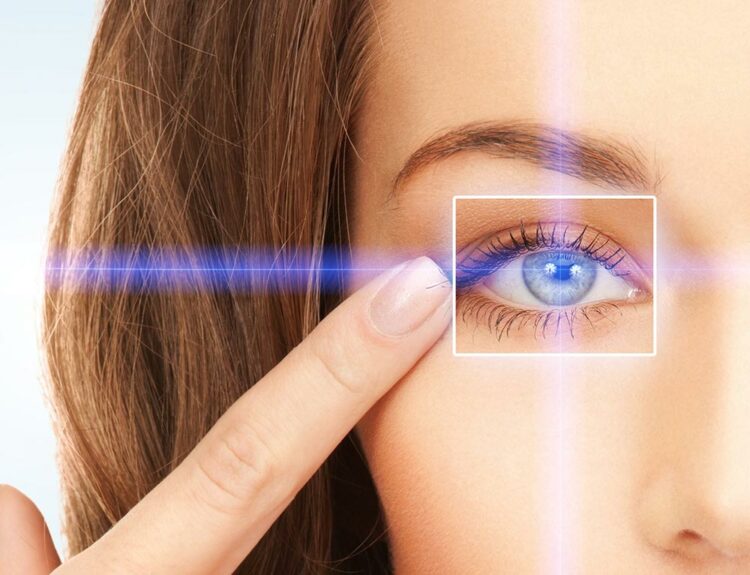LASIK and Refractive Surgery
LASIK Eye Surgery in San Antonio

Imagine being able to live your life — and see your best — without eyeglasses getting in the way, or the inconvenience of contact lenses (and solutions, cases, etc.). With LASIK, a form of refractive (vision-correction) surgery, you no longer have to wear specs or contacts in order to see and fully experience the world around you. Best of all, with today’s leading-edge LASIK methods, we can correct your vision more precisely and quickly than ever before.
MCOA’s state-of-the-art LASIK means optimal precision, comfort and vision outcomes
At Medical Center Ophthalmology Associates in San Antonio and Del Rio, we use today’s most advanced techniques, including all-laser bladeless LASIK, to make a profound, positive difference in your life. At the same time, we give you a wholly pleasant, comfortable patient experience. Our experienced, highly skilled eye surgeons combine advanced skill with state-of-the-art LASIK and other refractive-surgery techniques so you can achieve truly excellent outcomes and enjoy a short, comfortable procedure.
What is LASIK?
LASIK, laser-assisted in situ keratomileusis, is a procedure for correcting nearsightedness, farsightedness and astigmatism. LASIK itself involves using a laser to reshape the cornea. At the front of the eye, the clear, dome-shaped cornea — along with the lens — affects how light is focused on the retina (at the back of the eye).
Are you a candidate for LASIK surgery?
Take our LASIK self-test.
Who is a Good Candidate for LASIK?
To find out if you’re a good candidate for LASIK, you’ll need to attend a consultation with your ophthalmologist at Medical Center Ophthalmology Associates. They will ask you questions about your medical history, lifestyle, and visual goals and conduct a comprehensive eye exam to determine whether LASIK could be right for you.
Signs you are a good candidate for LASIK include:
- You are 18 or older
- You have had stable vision for at least one year
- You are not pregnant or breastfeeding
- You do not have autoimmune conditions that could interfere with the LASIK healing process, like rheumatoid arthritis, diabetes, lupus, or Sjögren’s syndrome
- You do not have cataracts, glaucoma, severe dry eye, or other serious eye conditions
- Your corneas are thick enough to safely create the flap needed for LASIK
- You are nearsighted, farsighted, or have astigmatism, and want freedom from visual aids
- You have realistic expectations about the results of LASIK
If you are not a good candidate for LASIK but still want to enjoy the benefits of permanent vision correction, your eye doctor may recommend one of the other refractive procedures offered at Medical Center Ophthalmology Associates, including PRK and EVO ICL.
What are the Benefits of LASIK?
Patients who choose LASIK at Medical Center Ophthalmology Associates have the opportunity to enjoy excellent benefits, such as:
Freedom From Visual Aids
LASIK can give you crisp, clear vision without glasses or contacts. This can not only eliminate everyday hassles like scrambling through your bag for glasses or performing a complex contact lens cleaning routine, but also enhance meaningful moments.
Imagine looking out at the view after a long hike with high-definition vision, exploring a new country with vibrant clarity, or watching your best friend tie the knot with perfect eyesight. LASIK can make every memory that much more vivid and allow you to focus on the things that matter rather than worrying about inconveniences like your glasses fogging up, contacts drying out, or forgetting your visual aids.
Improved Visual Acuity
LASIK can often provide more powerful vision correction than glasses or contacts. This is because the procedure corrects for your specific refractive errors, offering you truly customized vision. Many patients notice better depth perception and an enhanced field of vision, which can help with things like navigating new places, playing sports, and detail-oriented hobbies like painting or crocheting.
Quick, Easy Procedure
The LASIK procedure itself typically takes less than thirty minutes and is virtually painless, as your eyes will be numbed with anesthetic drops to ensure your comfort. Most patients only experience minimal side effects and can return to things like working and driving after just one day of recovery. This makes LASIK ideal for professionals with a busy schedule, as you won’t need to take extended time off to heal and can get right back into your routine within a matter of days.
Saves You Money in the Long Run
While LASIK has a higher upfront cost, most patients find they actually save money in the long run by choosing LASIK over visual aids. On average, glasses and contact lens wearers spend around $500 a year on visual aids and things like cleaning supplies, repairs, and refills. With payment plans like CareCredit offered at Medical Center Ophthalmology Associates, you can instead put that money towards gradually paying off your LASIK procedure. Once you’re done, you’ll own your vision. Clarity won’t depend on renewing your prescription or shelling out money to buy more daily contact lenses. Instead, you can enjoy permanent clear eyesight.
How to Prepare Before Your LASIK Procedure
Once your ophthalmologist determines you’re a good candidate for LASIK, they’ll give you instructions for preparation and the opportunity to ask any questions you may have. You’ll need to arrange for someone to drive you to and from your LASIK procedure, as well as to your first follow-up appointment. You can also help make your procedure and recovery process go smoother by:
- Wearing comfortable clothes to your appointment
- Preparing ready-made meals so you can relax post-procedure
- Download podcasts, music, or audiobooks to listen to while you heal
- Picking up your prescription eye drops before your procedure
What to Expect on the Day of Your LASIK Procedure
Before beginning the procedure, your LASIK surgeon will apply numbing eye drops so you don’t feel pain. They may also offer you a mild sedative if you are feeling anxious. Then, they will use a femtosecond laser to make a tiny flap on the surface of the cornea. Your LASIK surgeon will fold this flap back, reshape the underlying corneal tissue with an excimer laser, and then return the flap to its original place. Your eye will begin healing immediately, with no need for stitches.
What is LASIK Recovery Like?
After LASIK, you’ll need to have a friend or loved one drive you home. You should prioritize rest and relaxation to allow your body time to heal.
Some patients notice visual improvements immediately, with most enjoying better vision within the first 24-48 hours after the procedure. You’ll need to follow several postoperative instructions to ensure proper healing, including:
- Applying prescription eye drops according to your ophthalmologist’s schedule
- Avoiding getting water in your eyes
- Not rubbing or touching your eyes
- Wearing a protective eye shield while you sleep
- Refraining from strenuous physical activity
- Not driving until your eye doctor has cleared you
At your first follow-up appointment, which is typically the day following your LASIK procedure, your ophthalmologist will assess your vision and let you know when you can return to regular activities. Most patients are able to work and drive after just one day of recovery.
You can expect your vision to continue gradually improving until you reach peak clarity several months later. Then, you can enjoy decades of crisp, clear eyesight!
Complete refractive surgery backed by skill, experience and commitment
While LASIK is an acronym for this specific surgical procedure, it is often used today to describe any type of refractive surgery. Here at Medical Center Ophthalmology Associates, our board-certified ophthalmologists perform the full range of refractive surgeries and techniques. As a result, we can offer an alternative to glasses and contact lenses for a wide variety of patients, including those who may not be eligible for a particular approach. Here are the refractive surgeries we perform with experience and skill trusted by tens of thousands of patients:
- LASIK – Using a laser, your MCOA ophthalmologist makes a thin flap in the cornea. Through this flap, the surgeon very precisely removes corneal tissue with an excimer laser. Afterward, the flap is folded back and begins to heal in place, and the reshaped cornea bends (refracts) light differently than before, thereby improving your visual acuity.
- Photorefractive keratectomy (PRK) – For people whose corneas are too thin for LASIK, PRK offers an excellent alternative for correcting vision without glasses or contacts. The first type of laser vision correction, PRK has different initial steps, but still involves reshaping the cornea with an excimer laser.
- Implantable Collamer Lenses® (ICLs) – ICLs are basically implantable contact lenses that your MCOA eye surgeon can install over your natural lens through a microincision.
- Laser-assisted subepithelial keratomileusis (LASEK) – This variation on PRK is another alternative for certain patients. Less common than in previous years, LASEK remains one of the techniques we can use for patients not eligible for other approaches.
Trust subspecialization and leading-edge LASIK and vision-correction care
For LASIK and other vision-correction procedures, our track record for success is a reflection of our commitment… and our expertise. Our team of ophthalmologists includes multiple cornea subspecialists. This adds to our capabilities, as refractive procedures all involve surgery to the cornea. With this extra know-how, and our state-of-the-art methods and equipment, we’re able to achieve remarkable vision outcomes, minimize risk and get you out quickly and on your way.

